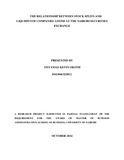| dc.description.abstract | Stock splits have attracted the attention of scholars and practitioners for a long period. A great
deal of discussions have been done on this phenomena that has at times been called a cosmetic
accounting change with no direct cost or benefits. Researchers and academicians have termed the
prevalence of splits as paradoxical because they have clear costs such as listing fees,
administrative costs and brokerage commissions yet no obvious economic benefits in terms of
favorable impact on future cash flows. However various studies have shown that this corporate
event exerts influence on various stock’s characteristics like liquidity and rates of return as
measured by different proxies. The prime concern of this study was to examine the effect of
stock splits on liquidity of firms listed in the Nairobi Securities Exchange. The measurement for
liquidity used is the Amihud’s Illiquidity ratio. The ratio defined here as the average ratio of the
daily absolute return to the (shilling) trading volume on that day. This ratio gives the absolute
(percentage) price change per shilling of daily trading volume, or the daily price impact of the
order flow. The trend analytical design which is a practice of collecting information and
attempting to spot a pattern or trend in information was employed to determine the relationship
between stock split and liquidity. To achieve the objective of the study, a census study was done,
drawing from thirteen companies listed in the Nairobi Stock Exchange and which had undergone
a stock split in the period 2004 to 2012. The data used was secondary data which was obtained
from the Nairobi Securities Exchange. The study made use of stock prices and trading volume
data for the event window of 61 days, consisting of 30 days before the stock split date and 30
days after the stock split date. The study found out that generally stock split resulted in a
decrease of liquidity in the NSE as opposed to the liquidity and trading range hypotheses.
Liquidity of stock was found to be generally higher in the days before the stock split than in the
days after the stock split. The aggregate liquidity for the month before the stock split was found
to be higher than the month after the stock split. | en_US |

